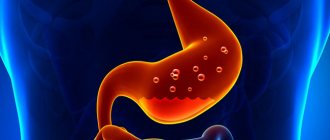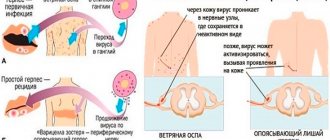Inflammatory diseases of the gastrointestinal tract are the most common reason for visiting a gastroenterologist. Such pathologies significantly reduce the quality of life and force a person to limit their diet. In addition, diseases of the digestive system always progress into more serious disorders.
To prevent gastritis from becoming chronic, it is necessary to begin therapy from the appearance of the first symptoms. This article will be useful for those who want to learn about inflammatory diseases of the stomach and how to cure chronic gastritis.
Acute gastritis
An acute form of inflammation of the stomach occurs a short period of time after exposure to negative factors on the mucous membrane of the organ.
Severe symptoms, including abdominal pain and indigestion, also occur quickly. Kinds:
- Fibrinous gastritis is an inflammation of the mucous membrane that occurs against the background of acid poisoning or a severe infectious disease.
- Catarrhal gastritis is an inflammation that occurs due to poor nutrition. It manifests itself as damage to the cells of the mucous membrane and migration of leukocytes to the site of inflammation.
- Necrotizing gastritis is a severe form of inflammation that occurs when various chemicals enter the organ. The disease is characterized by destruction of the mucous membrane and deeper tissues of the stomach walls.
With timely treatment, the acute form of the disease is characterized by a favorable prognosis.
Catarrhal gastritis
The most common is catarrhal gastritis. It also has another name - ordinary. The group of sick people includes those who eat poorly, get food poisoning, or take medications that are highly active and irritating. Acute forms quite often accompany this form of the disease; in this case, treatment is required urgently. The main cause of acute gastritis can be an infectious disease, a sudden disruption in metabolism, extensive breakdown of protein compounds due to burns and radiological injuries.
When treating catarrhal gastritis, it should be remembered that the surface epithelium is intensively infiltrated with leukocytes. Its dystrophy and necrobiotic lesions occur, and cases of inflammatory hyperemia are also common.
The appearance of catarrhal gastritis can be avoided. It is necessary to eat rationally and properly, observe the rules of hygiene, and treat your body more carefully. Treatment will not be required if you follow these simple rules.
Chronic gastritis
The chronic form of the pathology can occur independently or against the background of acute gastritis. Symptoms of the disease are not always pronounced, so inflammation can develop over many years. The most common cause of chronic gastritis is Helicobacter pylori infection.
Types of chronic gastritis:
- Autoimmune. Inflammation of the stomach occurs due to disruption of the body's defense systems.
- Reflux form, which occurs when the contents of the small intestine are constantly refluxed into the stomach.
- Bacterial form. Long-term invasion of Helicobacter pylori leads to dystrophic changes in the inner lining of the organ.
Doctors also distinguish other forms of chronic gastritis, including radiation and eosinophilic. To accurately determine the etiology of the disease, the results of instrumental and laboratory examinations are necessary.
Chronic gastritis - symptoms and treatment
Currently there is no generally accepted classification of the disease. In clinical practice in the Russian Federation, the working classification created on the basis of the classification of S.M. is most often used. Ryss and the Houston modification of the Sydney HG classification. It is compiled with the inclusion of clinical and functional sections, with their designation (in the spirit of the Sydney system) by the grammatical terms “inflection” (ending). The group of hCG type C also includes medicinal and professional forms of hCG.[7]
Working classification of CG
By etiology and pathogenesis (prefix):
- CG type A: autoimmune fundic atrophic, including those associated with megaloblastic Addison-Birmer anemia;
- CG type B: bacterial antral nonatrophic, associated with HP infection;
- CG type AB: combined atrophic pangastritis (with damage to all parts of the stomach).
According to topographic and morphological features (root or core):
- by localization:
- fundic hCG (type A);
- antral hCG (type B);
- pangastritis (type AB) with predominant damage to the antrum or fundus;
- according to morphological criteria:
- superficial CG;
- interstitial hCG;
- atrophic CG with mild, moderate or severe atrophy;
- CG with intestinal metaplasia (complete or incomplete, small intestinal or colonic).
According to specific morphological characteristics (suffix):
- according to the severity of the inflammatory process in the gastric mucosa:
- minimum;
- minor;
- moderate;
- pronounced (depending on the degree of lymphoplasmacytic inflammatory infiltration of the gastric mucosa);
- according to hCG activity:
- no activity;
- light (I);
- medium (II);
- ▪ high (III) (depends on the presence and severity of the neutrophilic - granulocytic component in the inflammatory infiltration of the gastric mucosa);
- according to the presence and severity of contamination of the coolant with HP infection:
- absent;
- light (I);
- medium (II);
- high (III);
According to clinical features:
- CG (type B) with a predominance of pain syndrome (Gastritis dolorosa);
- CG (type A) with a predominance of dyspeptic symptoms;
- CG with a latent (asymptomatic) course (~50%).
According to functional criteria (flexion), the following forms of chronic gastritis :
- HCG with preserved (and increased) secretion;
- CG with secretory insufficiency (moderate, severe, total).
Endoscopic criteria for hCG:
- erythematous (exudative) superficial CG;
- CG with flat (sharp) erosions;
- CG with rising (chronic) erosions;
- hemorrhagic hCG;
- hyperplastic hCG;
- HCG complicated by GDR (reflux gastritis).
When formulating a diagnosis, the following algorithm is used: Prefix (etiology) - Root (localization) - Suffix (morphology) - Inflection (function) with the addition of endoscopic criteria.
Example of diagnosis: Chronic Helicobacter gastritis of the antrum of the stomach with moderate inflammation, moderate activity, high contamination with Helicobacter pylorus with preserved secretion.
Due to the greater availability of morphological assessment of the condition of the gastric mucosa based on the results of studies of biopsy material, the CG classification according to the OLGA (Operative Link for Gastritis Assessment) system is increasingly being used. Over time, the morphological classification of CG will become the leading one in the world.
CG, like all chronic diseases, has two stages: exacerbations and remissions, which successively replace each other. With each exacerbation, greater structural changes occur in the mucosa. Exacerbation and remission of hCG can be confirmed clinically or endoscopically (the most accurate confirmation is based on the results of endoscopy and the morphology of the biopsy material).
Based on the cause of occurrence, the following types of chronic gastritis : caused by Helicobacter Pylori infection, drug-induced and autoimmune atrophic gastritis.
Caused by Helicobacter Pylori infection (HP infection)
Currently, HP infection (type B gastritis) plays a leading role in the development of CG. The majority of adults over 60 years of age are infected with this bacterium. In Russia, among children over 5 years old, 30% are infected, at the age of 15-20 years - 63%, adults - more than 85% [10]. The pathogenesis of the effect of this pathogen on the stomach is that chronic Helicobacter Pylori infection causes changes in the tissues of the gastric mucosa. For a long time, the infection occurs without symptoms. As inflammation spreads to the body of the stomach and the response of the mucous membrane increases, the first symptoms of gastritis appear. The longer the infection lasts, the stronger the restructuring of the mucous membrane. This restructuring of the mucosa consistently leads to atrophy, intestinal metaplasia and dysplasia, leading to gastric cancer. The development of gastric atrophy is a critical step in the transition of hCG to gastric cancer.
Drug-induced gastritis (type C)
This is the second most common form of gastritis. The effect on the stomach of non-steroidal anti-inflammatory drugs (NSAIDs) has been most studied. They do not cause direct aggressive action, like acids (hydrochloric acid is tens of times more aggressive). The pathogenesis of their effect on the gastric mucosa is based on the blocking of cyclooxygenase enzymes (isomers COX-1 and COX-2). When COX-1 is blocked, the synthesis of prostaglandins (E2 and I2) is suppressed, which ensure the quality and strength of the mucosal barrier that protects the mucous membrane from the aggressive effects of hydrochloric acid and pepsin. Therefore, long-term use of NSAIDs leads to a thinning of the protective layer of mucus and an increase in the aggressive effect of hydrochloric acid on the gastric mucosa, causing chronic inflammation.
Autoimmune atrophic gastritis (type A gastritis)
The rarest form of hCG is autoimmune atrophic gastritis (type A gastritis). Until now, its etiology is not known. It is based on the production of antibodies by immune cells to the parietal cells of the mucous membrane (synthesize hydrochloric acid) and the internal factor of Castle (participates in the absorption of iron in the intestine). As a result of this, inflammatory changes develop, very early leading to atrophy and achlorhydria (a condition in which there is no hydrochloric acid in the gastric juice). The metabolism of vitamin B12 is also disrupted, aggravating the course of anemia.
In addition to those listed, there is a group of specific types of chronic gastritis.
Radiation gastritis - the causative factor is ionizing radiation, which has both a direct damaging effect on the mucous membrane and through a cascade of reactions with the formation of free radicals and lipid peroxidation of cell membranes. As a result, with prolonged exposure to doses of ionizing radiation exceeding the maximum threshold, chronic radiation gastritis develops.
Lymphocytic gastritis is characterized by specific inflammation in the gastric mucosa, which develops against the background of gluten enteropathy - celiac disease (a pathological disorder of the intestines in which gluten intolerance occurs). The mucous membrane is damaged by its own antibodies with the development of chronic inflammation.
Granulomatous gastritis develops as a result of the involvement of the stomach in the inflammatory process in Crohn's disease (chronic inflammatory bowel disease) and occurs with similar mucosal lesions in the form of erosions and ulcers. Specific foci of chronic inflammation, granulomas, form in the mucosa.
Eosinophilic chronic gastritis develops with food allergies. If you do not follow a diet that excludes the allergen, chronic inflammation develops in the gastric mucosa. The more often allergens enter the stomach, the more pronounced the manifestations of gastritis.
The course of chronic gastritis
CG is a long-term disease: on average, 18-25 years pass before the development of pronounced structural changes in the gastric mucosa in the form of atrophy, dystrophy or dysplasia. Over time, each exacerbation leads to the spread of the inflammatory process not only over the area (breadth), but also into the depth of the mucous membrane. When the body and fundus of the stomach are involved in the process, the production of hydrochloric acid and pepsin begins to decrease, which leads to digestive disorders.
Causes
Gastritis is a polyetiological disease. In 90% of cases, inflammation of the stomach occurs against the background of Helicobacter pylori invasion into the mucous membrane of the organ. The activity of the bacterium leads to the gradual destruction of the protective film of the stomach, as a result of which hydrochloric acid begins to damage the epithelium and other tissues. The bacterium is found in the stomach of almost every second person, but not all people's carriage causes damage to the organ.
Other reasons:
- An acute bacterial infection that occurs when E. coli, staphylococcus or streptococcus penetrate an organ.
- Other types of infectious diseases, including tuberculosis and candidiasis.
- Reflux disease of the gastrointestinal tract, characterized by the reflux of the contents of the duodenum into the stomach. Bile acids and other substances can damage the walls of the organ.
- Poisoning with acids, alkalis, heavy metals, salts and other chemicals that damage the tissues of the gastrointestinal tract.
- Inflammatory and autoimmune processes in other parts of the digestive system, including chronic duodenitis and Crohn's disease.
- Adverse effects of drugs. Damage to the gastric mucosa can occur while taking non-steroidal anti-inflammatory drugs, glycosides, corticosteroids and some antibiotics.
- Bad habits. Alcohol and substances contained in tobacco smoke irritate the mucous membranes of organs.
- An allergic reaction in which the body attacks the lining cells of the stomach.
The factors listed above cause the development of the disease in most cases.
Cause of the disease
Let's try to understand the reasons for CG. Let us divide the causal factors into external (exogenous) and internal (endogenous):
External ones include:
- eating disorder: the majority of the working population sins by eating according to the principle “either empty, then thick”, without having full meals all day, and after a working day - “breaking off completely”, thereby disrupting all digestive processes, including those that are carried out in the stomach. The body “endures” for a certain period of time (depending on the initial safety margin), and then “takes revenge.” HCG is one of the manifestations of this “revenge” for an incorrect attitude to nutrition;
- smoking and alcohol abuse (it has been proven that contact exposure to cigarette smoke can lead to superficial gastritis);
- prolonged neuropsychic overload;
- occupational hazards (metal and cotton dust, vapors of alkalis and acids, etc.);
- Helicobacter pylori. I would like to stop at this point, because... Recently, pharmaceutical companies have been actively using this microorganism to lead to increased sales of certain drugs. But I would like to remind you that Helicobacter pylori belongs to the saprophytic flora, i.e. to opportunistic, which only under certain conditions acquires pathogenicity properties (in combination with erosive and ulcerative lesions of the gastric and duodenal mucosa). And all other things being equal, this microorganism can be found in the gastrointestinal tract of 80-90% of the population and not cause any harm to health.
External factors include:
- chronic infections (oral cavity and nasopharynx, nonspecific and specific diseases of the respiratory system, including gastrointestinal tuberculosis);
- diseases of the endocrine system (autoimmune thyroiditis with hypothyroidism, thyroid disease with hyperthyroidism, Itsenko-Cushing's disease, type 1 diabetes mellitus);
- diseases associated with metabolic disorders (obesity, gout, etc.)
- diseases leading to tissue hypoxia (heart failure, respiratory failure), i.e. the so-called ischemic mechanism of damage to the gastric mucosa;
- autointoxication (uremia, etc.);
- food allergies, etc.
Risk factors
In addition to the above reasons for the formation of gastritis, it is worth paying attention to the risk factors for the disease. These are conditions associated with lifestyle, heredity and the patient’s individual history.
Main risk factors:
- Poor nutrition. Excessive consumption of fatty, spicy or salty foods increases the risk of developing gastritis. In addition, carbonated drinks, crackers, chips and other types of fast food are harmful to the gastrointestinal tract.
- Prolonged stress. A psychological state can affect the organ by affecting the secretion of gastric juice. With chronic stress, acid is constantly released in the stomach.
- Elderly age. The pathology is most often diagnosed in men and women over 60 years of age.
- Diseases that negatively affect the immune system. First of all, these are HIV infection and congenital immunodeficiencies.
- Unfavorable heredity. Predisposition to the disease can be transmitted to the patient from parents.
Taking risk factors into account allows for effective preventive measures.
Diet
- In case of exacerbation of gastritis, a gentle diet is necessary. Patients with gastritis are contraindicated in chocolate, coffee, carbonated drinks, alcohol, canned food, concentrates and substitutes of any products, herbs, spices, as well as fast food products, dishes that provoke fermentation (milk, sour cream, grapes, black bread, etc.) , smoked, fatty and fried foods, pastry products. At the same time, food should be varied and rich in proteins and vitamins.
- After the end of the acute condition, nutrition should become complete, observing the stimulating principle during the period of remission in patients with low acidity. Small meals are recommended, 5-6 times a day.
Symptoms
Manifestations of the disease depend on the form of inflammation. Symptoms of acute gastritis occur suddenly against the background of exposure to negative factors on the stomach. Patients complain of pain in the upper abdomen, nausea and vomiting. Pain is also characterized by chronic gastritis with increased secretory activity of the organ, since with this disease an excess amount of hydrochloric acid is formed. Inflammation with a decrease in the secretory activity of the stomach most often manifests itself as mild symptoms.
Additional symptoms:
- pain in the chest and neck area (heartburn);
- constant belching;
- loss of appetite;
- frequent urge to defecate;
- decreased performance;
- insomnia;
- bloody vomiting;
- black stool (melena);
- white coating on the tongue;
- bloating;
- worsening mood.
If any of the above symptoms appear, you must make an appointment with a gastroenterologist.
Phlegmonous gastritis
The phlegmonous type of the disease is not widespread. It is characterized by the development of phlegmonous inflammatory foci on the walls of the stomach. In this case, pus is secreted mainly in the submucosal layer. Phlegmonous gastritis, as a rule, is recognized during surgical operations on suspicion of perigastritis and peritonitis. It is caused by various pathogens - streptococci, staphylococci, pneumococci and Proteus. In some cases, the cause of the disease may be gastric ulcer, decaying stomach cancer, abdominal trauma, sepsis, typhoid fever, etc.
Symptoms include chills and fever in the patient, pain in the upper abdominal region, bouts of vomiting, and constant nausea. In this case, bloating of the abdomen is clearly visible, and dryness is clearly felt in the mouth. The condition is deteriorating sharply. I lose my appetite and don’t even want to drink. Active exhaustion sets in. This is expressed too clearly, especially in facial features.
Any palpation of the abdomen is extremely painful for a person. A blood test reveals significantly increased neutrophilic leukocytosis with toxic granularity, high ESR, and disturbances in protein structures.
Treatment should not be delayed. Its complications will be dangerous. The disease provokes the appearance of pleurisy, thrombophlebitis of the peritoneal vessels, liver abscess and other serious diseases.
Complications
Without treatment, acute or chronic gastritis can cause a variety of complications. Some negative consequences of the pathology can threaten the patient's life.
Possible complications of gastritis:
- Ulcerative lesions of the stomach and small intestine.
- Gastrointestinal bleeding. Symptoms of this complication include pale skin, weakness, sweating, dizziness and low blood pressure.
- Perforation of the organ wall with the risk of extensive inflammation.
- Megaloblastic anemia, manifested by weakness, constant fatigue and dizziness.
- Malignant neoplasm of the stomach.
Dangerous negative consequences of acute inflammation can occur within several days.
Chronic gastritis with normal and increased secretory function of the stomach
This type of disease is typical for young men. The surface epithelium of the stomach is affected; as a rule, no destruction occurs in the mucous membrane. Patients feel pain similar to that of an ulcer. After eating, they have a feeling of internal heaviness. Patients constantly complain of heartburn and unpleasant belching. The majority of them suffer from constipation. All these phenomena intensify at night.
Diagnostics
In most cases, detecting gastritis is not difficult. To undergo a comprehensive examination, you must make an appointment with a gastroenterologist. The doctor will ask the patient about complaints and examine medical history. A general examination sometimes reveals external manifestations of the disease. The diagnosis is made after analyzing the results of instrumental and laboratory examinations. If acute abdominal pain occurs due to a gastrointestinal disorder, a doctor can be called to your home.
Examination methods used:
- Esophagogastroduodenoscopy is a standard examination method for suspected gastritis or gastric ulcer. The doctor asks the patient to lie on his side and open his mouth wide. The root of the tongue is treated with lidocaine, after which a flexible tube equipped with a camera and a light source is inserted into the gastrointestinal tract. During the examination, the doctor can examine the condition of the mucous membrane of the stomach and intestines by looking at the monitor. This is the most informative type of diagnosis.
- A biopsy of the gastric mucosa is the collection of a small number of organ cells for subsequent histological examination and determination of the cause of the disease. A painless biopsy is usually performed during an esophagogastroduodenoscopy.
- X-ray of the organ. A contrast agent is first injected into the stomach. The resulting image helps to detect indirect signs of inflammation.
- Study of the acid-base state of the stomach contents (pH-metry). This study helps determine the type of gastritis and evaluate the effectiveness of therapeutic treatment of the disease.
- Breath test to detect bacterial gastritis. Using a special device, the concentration of carbon in exhaled air is assessed. An excess of this substance indicates Helicobacter pylori infection.
If necessary, your doctor may need additional tests, including blood tests and an ultrasound examination of the digestive system. The use of several diagnostic methods allows a specialist to prescribe more effective and safe treatment.
Giant hypertrophic gastritis
Doctors call this gastritis by different names - tumor-like, Ménétrier's disease, polyadenoma, etc. Many adenoma or cystic seals form in the gastric mucosa. It becomes rough, ugly folds appear on it, and the surface is characterized by hypoproteinemia.
The disease can be recognized through x-rays and gastrofibroscopic examination. In this case, a biopsy is also appropriate. Upon examination, it becomes noticeable that the distension of the stomach is dosed, and the gastric folds are smoothed out. This does not happen with tumors.
If the patient drinks alcohol and does not adhere to a diet, then treatment in this case will be complicated by bleeding. The occurrence of malignant formations cannot be ruled out.
In the entire history of medicine, there has never been a doctor who would know exactly how to cure chronic gastritis completely. In most cases, the general condition of the patients only improves, the acute manifestations of the disease decrease, but changes in the mucous membrane of the stomach, its tissues and disturbances in its functioning still remain.
Diagnosing acute types of disease is not difficult. The signs are too obvious. In chronic forms, the presence of the disease is also confirmed by data obtained during gastrofibroscopy and biopsy.
Laboratory and clinical studies of patients make it possible to separate diseases such as gastritis with preserved and increased gastric secretion, antral gastritis from peptic ulcer disease. In addition, it should be remembered that peptic ulcer disease is characterized by seasonal exacerbations. In gastritis, this symptom is absent, and during exacerbations, ulceration of the mucous membrane is not observed.
The polypous form of the disease is well detected by targeted biopsy, the antral and hypertrophic form - by gastrofibroscopy and biopsy.
Treatment
The treatment regimen is selected by the doctor after determining the factor that caused the inflammatory process and clarifying the form of the disease. You can read more about modern methods of treating gastritis in the article:. Without fail, along with drug therapy, the patient is prescribed a therapeutic diet. Strict cessation of smoking, alcoholic beverages, certain medications and junk food is required. The recommended diet for gastritis also depends on the form of inflammation.
Prescribed medications:
- Antibiotics necessary to eliminate Helicobacter pylori infection. It is possible to prescribe several antibiotics simultaneously along with proton pump inhibitors and bismuth-based drugs. Other types of stomach infections are treated with anti-inflammatory or antifungal medications.
- Protective drugs that protect the gastric mucosa from adverse effects. Enveloping agents help prevent acid from attacking the walls of the organ. Doctors usually prescribe acid-neutralizing antacids to patients. These drugs cannot be used on an ongoing basis, so the course must be limited.
- Medicines that affect the secretory function of the organ. First of all, these are proton pump inhibitors and H2-histamine receptor blockers, which are required for excess gastric acidity. These medications normalize the condition of the organ within 24 hours. Pepsin supplementation is required when gastric secretory activity is insufficient.
Additional medications used for other forms of gastritis include corticosteroids, sorbents and antidotes. In severe cases, the patient may require infusion therapy and surgical treatment. It is important to remember that the main method of preventing the disease is a healthy diet.
Corrosive gastritis
Corrosive types of disease occur when strong acidic and alkaline ingredients, salts of heavy metals, and saturated ethyl alcohol enter the human body.
Suspicions of corrosive gastritis can be caused by such signs as severe pain behind the sternum, in the mouth or in the epigastric region. It's almost impossible to tolerate her. Unpleasant sensations increase with bouts of vomiting. The escaping masses may contain blood, mucus, and tissue particles. An unpleasant picture is added by swelling of the lips, mucous membranes in the mouth and larynx. Sometimes ulcers, scabs, and whitish spots appear. The voice becomes hoarse and breathing becomes irregular. Collapse is also common. The abdomen itself is usually noticeably swollen. Even slight palpation causes pain. Irritation of the peritoneal area also occurs.
Of course, in such a situation, treatment must begin immediately. Otherwise, the inflammatory process and destructive phenomena can develop into serious consequences. After a few days, death may occur due to the patient's shock or peritonitis. You should not self-medicate for corrosive gastritis. Only a professional can draw up a correct and prompt plan for how to treat this type of gastritis. The corrosive form of the disease leads to tissue scarring in the pyloric and cardiac parts of the stomach.
Bacterial gastritis: is Helicobacter pylori really dangerous?
As we have already noted, bacterial gastritis, the culprit of which is the bacterium Helicobacter pylori (Helicobacter), is common in 80-90% of cases of all gastritis. This bacterium is transmitted through household contact (through dishes, kisses), and in the stomach it exhibits extremely aggressive behavior. In a short time, it multiplies in the mucous membrane and secretes destructive enzymes - urease. Under their influence, urea, which is contained in the stomach, turns into ammonia. Thus, Helicobacter breaks down the protective mucus, exposing the stomach wall, and then provokes inflammation, ulcers and metaplasia, which carries an oncological risk.
The bacterium Helicobacter pylori has been studied relatively recently. It was discovered in 1979 by Robin Warren
- Pathologist at the Royal Perth Hospital.
He studied the contents of the stomachs of patients with gastritis and accidentally discovered in many of them a spiral-shaped bacterium that multiplied safely even in a very acidic environment. A few years later, a desperate scientist-enthusiast named Barry Marshall
drank a test tube of Helicobacter cultures, after which he almost died from severe gastritis. In 2005, both researchers were awarded the Nobel Prize for their discoveries.
Today, WHO names the bacterium Helicobacter pylori as the No. 1 cause of stomach cancer worldwide. But don’t rush to get scared!
It is interesting that carriers of this bacterium in developed countries are 25-30% of the population, in Russia and Japan - 60-80%, and in Africa - 100%. And this has been going on for several millennia. Yes, predisposition to gastritis also depends on the population. In the body of a healthy person, there is a constant war between the immune system and Helicobacter pylori. The bacterium wins only sometimes, so many Helicobacter carriers do not develop inflammation of the stomach wall.
However, according to the European consensus recommendations and the Kyoto global agreement, treatment and observation for Helicobacter pylori is still necessary. Especially for residents of countries with a high risk of developing stomach cancer (Russia and Japan), as well as patients who are at risk for gastritis, that is, with poor heredity, concomitant pathologies, vitamin B12 deficiency, etc.
The gold standard for diagnosing Helicobacter are special test strips based on contact of blood with a reagent, as well as a 13C-urease breath test. If the result is positive, the patient is prescribed a gastroscopy. To get rid of Helicobacter pylori, a course of antibiotic therapy is usually sufficient. However, as we already know, antibiotics are not good for our stomach, since they also kill beneficial microorganisms. Therefore, only a doctor can select the necessary medications after studying the anamnesis and examination. The presence of Helicobacter pylori itself usually does not provoke gastritis - additional triggers are needed.
To prevent Helicobacter pylori invasion in the stomach, you should regularly visit the dentist (since this bacterium lives comfortably not only in the stomach, but also between the teeth, in tartar) and, of course, keep your hands, dishes, vegetables and fruits clean. If one of the family members is diagnosed with Helicobacter, this does not mean at all that you need to panic, quarantine the carrier of the virus and urgently treat everyone in the family.







